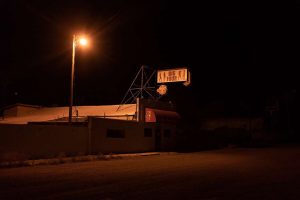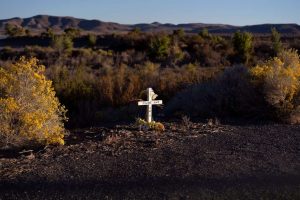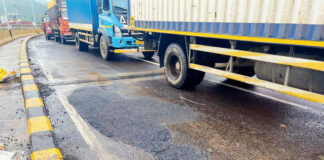FEBRUARY 23, 2019
 A street lamp casts Big Four Ranch in golden light. It is one of 21 legal brothels in Nevada. – Photograph by Mathias Svold, National Geographic
A street lamp casts Big Four Ranch in golden light. It is one of 21 legal brothels in Nevada. – Photograph by Mathias Svold, National Geographic
Where the state of Nevada folds in half—from the elbow on its western arm at Lake Tahoe across to its Utah border—you’ll find the most direct route across the state. It crosses several communities, a handful of mountain ranges, a national park, and one reservoir, where bobcats, foxes, and wild horses roam free. There’s life, yes, but not a familiar way of life for many. It’s a place where the lines between John Wayne Westerns and everyday life blur, where ghost towns bleed into living ones. This is Route 50, the Loneliest Road in America.
 A lone, white cross marks the roadside between Fallon and Silver Springs, Nevada. – Photograph by Mathias Svold, National Geographic
A lone, white cross marks the roadside between Fallon and Silver Springs, Nevada. – Photograph by Mathias Svold, National Geographic
Or so says Life magazine. In July 1986, the publication honored the Statue of Liberty’s 100th birthday and highlighted American superlatives: On one page, the “Cutest” (a toddler actor) appears alongside the “Loneliest Road” below a photo of a seemingly endless highway that reaches across the desert toward the mountains, a lone cowboy on horseback crossing from one side of nothingness to the other. An anonymous AAA counselor is quoted in the article: “We warn all motorists not to drive there, unless they’re confident of their survival skills.”
Rather than keep motorists away, however, the moniker piqued curiosity—thanks in part to the Nevada Commission on Tourism. The public relations director at the time saw an opportunity in the article and released a Highway 50 survival guide the same month the Life article came out, rewarding visitors to the area with a certificate of survival signed by the governor. Highway signs touting the qualifier went up along the route at the same time, and it graduated from opinion to slogan.
Before it was known as the Loneliest Road in America, Route 50 was anything but. In the 1850s, the Gold Rush sparked a caravan of wagons to head West along the thruway. According to the Highway 50 Association, the Roaring Road (as it was called) became so congested at times that hopeful miners and their families would have to wait days before they could access it—a Panama Canal of sorts, standing between the new frontier and the old.
By the turn of the century, the road became California’s first State Highway and eventually connected the nation’s Atlantic and Pacific coasts. To this day, the California Department of Transportation calls Route 50 the “backbone of America.”
And yet, as photographer Mathias Svold sat in his car along a network of dirt roads surrounded by miles and miles of yellow-and-red desert grass and the rattlesnake he had just narrowly avoided stepping on, it didn’t feel like that. “I was overwhelmed,” the Copenhagen-based photographer recalls. “On one side, with the beautiful nature, but also the snake reminded me that this is a dangerous environment. It was just me alone in the desert—with a snake.”
That sort of isolation follows Route 50 for almost the entirety of its 400 miles across Nevada, but it’s particularly pronounced along this stretch, the 287 miles between Ely and Fernley designated by Life as the Loneliest Road. Here, you can’t count on cell service or gas stations, on places to eat or even people to wave at as you pass—anything to replace the eeriness of the hungry red desert around you. Even its small towns seemingly materialize and then fade into the distance like a mirage. (Meet the man who has lived alone on an island for 28 years.)
“From an economic development standpoint, we’re not considered rural,” says Dee Helming, chairwoman of the Pony Express Territory, which works with the state tourism authority to promote the towns along Route 50. “We’re considered frontier.”
That’s precisely the draw for some of its residents. “There’s just a mystique about Nevada,” says Helming. She moved to Austin, one of the few towns along the highway, in 1981 and today owns a laundromat, a bed and breakfast, and a cafe with her husband, Kip.
“For us, it’s that freedom of living old school, I guess. It’s a whole different way of life. Your community is more dependent on each other. You have to understand, you’re 112 miles from the nearest Walmart; you’re 110 miles from the nearest stoplight. You learn a lot of independence.”
She encourages her B&B guests to discover the outdoors, get intimate with the history, and wander the ghost towns—to experience the very life that she and others along the highway live every day. “They either love it or they’re so intimidated that they’ll never come back.” (She arrived a tourist. The island inspired her to become its sole nun.)
But Svold discovered that isolation wasn’t the only challenge to overcome. Nevada is the only state in the U.S. where prostitution is legalized, and in Ely, he came across Big Four Ranch, a historic brothel that dates back to the 1880s. Even knocking on the door took courage—he feared the unfamiliar. “Then I met Bobby,” says Svold, “and he is like a teddy bear.”
Bobby McShane, head of maintenance, has worked at Big Four for the better part of two decades. After welcoming Svold inside and grabbing a beer, he pointed out paintings of a woman that hung all around the barroom. According to McShane, a customer fell in love with one of the women working at the brothel—the same woman who looked down at them from her many frames. He spent all his money on her. “He painted these really beautiful paintings of her to pay the debt,” Svold says. “In Denmark brothels are not illegal, but they are taboo. But Bobby was romanticizing the stories from there, telling them like love stories.”
Perhaps, thought Svold, the Loneliest Road in America isn’t so lonely after all. It’s big and vast and seemingly endless, and in that there’s solitude, yes, but not sadness.
“Anybody can go there and look around and say, ‘Wow, this is lonely,’ and then leave and go back to where they came from,” says Svold. “But people who live there, it’s a permanent mindset. The difference is in having the solitude inside you, instead of it being a temporary feeling.”
Courtesy/Source: National Geography










































































































